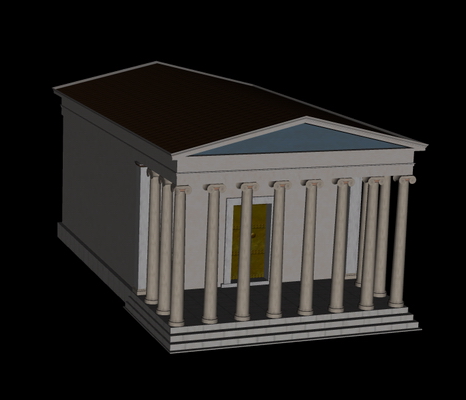Together with the Southwest Temple, with which it is intimately related, this proved one of the most problematic buildings for the digital reconstruction project. Its erection is dated to the late 1st cent. BC / early 1st cent. AD according to one view, or to the early 2nd cent. BC according to an alternative opinion, therefore we have included it only in the Roman period representation. The lower layers of the wall slabs of the cella and the pronaos (these are made up of different material) are preserved in situ, which means the building and the cella’s dimensions are known, as well as the thickness of the walls. Limestone slabs in secondary use held together by grey mortar were employed for the cella, while in the pronaos, which was more carefully constructed, the masonry is of large square limestone slabs.
For the representation of the superstructure and the building’s general form there are two wholly conflicting theories. According to Thompson, the building should be supplemented with material consisting of columns and capitals made of marble characteristic of the Thorikos area, originating probably from a temple or a stoa from this remote Athenian deme, which during the period of the material’s relocation (1st cent. BC – 1st cent. AD) was in a state of decline. There is more material, reworked so as to fit into a similar building.
H.A. Thompson [‘Activities in the Athenian Agora: 1959’,
Hesperia 29 (1960), pp. 339-343] claims this material should be provisionally attributed to the Southeast Temple, which is represented with a Doric frieze of 12 triglyphs and 11 metopes, that is an arrangement of 6 × 2 columns, with a central intercolumniation rather larger than the rest. On the contrary, W.B. Jr. Dinsmoor [‘Anchoring Two Floating Temples’,
Hesperia 51 (1982), 410-451, plates 95-96] represents a temple of the octastyle prostyle type, with a depth of 3 columns, not supplemented with the Doric capitals, but with parts from the Temple of Athena Sounias, relocated at some point to the Athenian Agora and later (3
rd cent. AD) incorporated in the Late Roman defensive wall. The second hypothesis has been accepted by most recent scholars [e.g. Mc Camp II, J.,
Η Αρχαία Αγορά της Αθήνας. Οι Ανασκαφές στην καρδιά της κλασικής πόλης2 (Αθήνα 2004), pp. 222-224], although there are some exceptions [Osanna, M., ‘Thesmophorion ed Eleusinion ad Atene: problemi topografici e culturali’,
Ostraka IV.1 (1995), pp. 103-118].

SE-Temple, 3D representation

